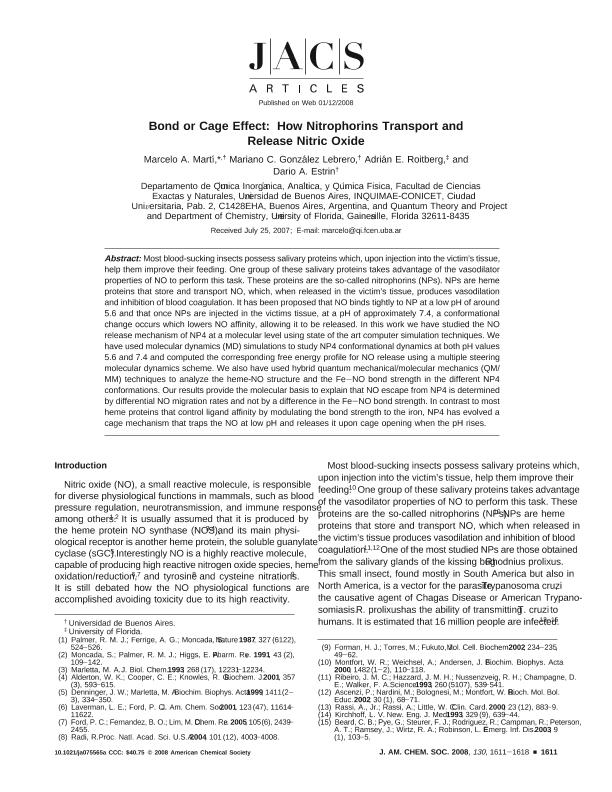Mostrar el registro sencillo del ítem
dc.contributor.author
Marti, Marcelo Adrian

dc.contributor.author
González Lebrero, Mariano Camilo

dc.contributor.author
Roitberg, Adrián E.
dc.contributor.author
Estrin, Dario Ariel

dc.date.available
2020-04-21T16:09:25Z
dc.date.issued
2008-02
dc.identifier.citation
Marti, Marcelo Adrian; González Lebrero, Mariano Camilo; Roitberg, Adrián E.; Estrin, Dario Ariel; Bond or Cage Effect: How Nitrophorins Transport and Release Nitric Oxide; American Chemical Society; Journal of the American Chemical Society; 130; 5; 2-2008; 1611-1618
dc.identifier.issn
0002-7863
dc.identifier.uri
http://hdl.handle.net/11336/103171
dc.description.abstract
Most blood-sucking insects possess salivary proteins which, upon injection into the victim's tissue, help them improve their feeding. One group of these salivary proteins takes advantage of the vasodilator properties of NO to perform this task. These proteins are the so-called nitrophorins (NPs). NPs are heme proteins that store and transport NO, which, when released in the victim's tissue, produces vasodilation and inhibition of blood coagulation. It has been proposed that NO binds tightly to NP at a low pH of around 5.6 and that once NPs are injected in the victims tissue, at a pH of approximately 7.4, a conformational change occurs which lowers NO affinity, allowing it to be released. In this work we have studied the NO release mechanism of NP4 at a molecular level using state of the art computer simulation techniques. We have used molecular dynamics (MD) simulations to study NP4 conformational dynamics at both pH values 5.6 and 7.4 and computed the corresponding free energy profile for NO release using a multiple steering molecular dynamics scheme. We also have used hybrid quantum mechanical/molecular mechanics (QM/MM) techniques to analyze the heme-NO structure and the Fe−NO bond strength in the different NP4 conformations. Our results provide the molecular basis to explain that NO escape from NP4 is determined by differential NO migration rates and not by a difference in the Fe−NO bond strength. In contrast to most heme proteins that control ligand affinity by modulating the bond strength to the iron, NP4 has evolved a cage mechanism that traps the NO at low pH and releases it upon cage opening when the pH rises.
dc.format
application/pdf
dc.language.iso
eng
dc.publisher
American Chemical Society

dc.rights
info:eu-repo/semantics/openAccess
dc.rights.uri
https://creativecommons.org/licenses/by-nc-sa/2.5/ar/
dc.subject
protein molecular dynamics
dc.subject.classification
Físico-Química, Ciencia de los Polímeros, Electroquímica

dc.subject.classification
Ciencias Químicas

dc.subject.classification
CIENCIAS NATURALES Y EXACTAS

dc.title
Bond or Cage Effect: How Nitrophorins Transport and Release Nitric Oxide
dc.type
info:eu-repo/semantics/article
dc.type
info:ar-repo/semantics/artículo
dc.type
info:eu-repo/semantics/publishedVersion
dc.date.updated
2020-04-17T14:35:00Z
dc.journal.volume
130
dc.journal.number
5
dc.journal.pagination
1611-1618
dc.journal.pais
Estados Unidos

dc.journal.ciudad
Washington
dc.description.fil
Fil: Marti, Marcelo Adrian. Consejo Nacional de Investigaciones Científicas y Técnicas. Oficina de Coordinación Administrativa Ciudad Universitaria. Instituto de Química, Física de los Materiales, Medioambiente y Energía. Universidad de Buenos Aires. Facultad de Ciencias Exactas y Naturales. Instituto de Química, Física de los Materiales, Medioambiente y Energía; Argentina
dc.description.fil
Fil: González Lebrero, Mariano Camilo. Consejo Nacional de Investigaciones Científicas y Técnicas. Oficina de Coordinación Administrativa Ciudad Universitaria. Instituto de Química, Física de los Materiales, Medioambiente y Energía. Universidad de Buenos Aires. Facultad de Ciencias Exactas y Naturales. Instituto de Química, Física de los Materiales, Medioambiente y Energía; Argentina
dc.description.fil
Fil: Roitberg, Adrián E.. University of Florida; Estados Unidos
dc.description.fil
Fil: Estrin, Dario Ariel. Consejo Nacional de Investigaciones Científicas y Técnicas. Oficina de Coordinación Administrativa Ciudad Universitaria. Instituto de Química, Física de los Materiales, Medioambiente y Energía. Universidad de Buenos Aires. Facultad de Ciencias Exactas y Naturales. Instituto de Química, Física de los Materiales, Medioambiente y Energía; Argentina
dc.journal.title
Journal of the American Chemical Society

dc.relation.alternativeid
info:eu-repo/semantics/altIdentifier/url/https://pubs.acs.org/doi/full/10.1021/ja075565a
dc.relation.alternativeid
info:eu-repo/semantics/altIdentifier/doi/http://dx.doi.org/10.1021/ja075565a
Archivos asociados
